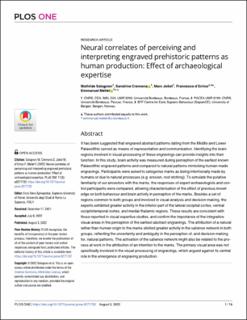| dc.contributor.author | Salagnon, Mathilde | |
| dc.contributor.author | Cremona, Sandrine | |
| dc.contributor.author | Joliot, Marc | |
| dc.contributor.author | d'Errico, Francesco | |
| dc.contributor.author | Mellet, Emmanuel | |
| dc.date.accessioned | 2023-03-08T10:13:41Z | |
| dc.date.available | 2023-03-08T10:13:41Z | |
| dc.date.created | 2022-10-24T10:22:44Z | |
| dc.date.issued | 2022-08-03 | |
| dc.identifier.issn | 1932-6203 | |
| dc.identifier.uri | https://hdl.handle.net/11250/3056969 | |
| dc.description.abstract | It has been suggested that engraved abstract patterns dating from the Middle and Lower Palaeolithic served as means of representation and communication. Identifying the brain regions involved in visual processing of these engravings can provide insights into their function. In this study, brain activity was measured during perception of the earliest known Palaeolithic engraved patterns and compared to natural patterns mimicking human-made engravings. Participants were asked to categorise marks as being intentionally made by humans or due to natural processes (e.g. erosion, root etching). To simulate the putative familiarity of our ancestors with the marks, the responses of expert archaeologists and control participants were compared, allowing characterisation of the effect of previous knowledge on both behaviour and brain activity in perception of the marks. Besides a set of regions common to both groups and involved in visual analysis and decision-making, the experts exhibited greater activity in the inferior part of the lateral occipital cortex, ventral occipitotemporal cortex, and medial thalamic regions. These results are consistent with those reported in visual expertise studies, and confirm the importance of the integrative visual areas in the perception of the earliest abstract engravings. The attribution of a natural rather than human origin to the marks elicited greater activity in the salience network in both groups, reflecting the uncertainty and ambiguity in the perception of, and decision-making for, natural patterns. The activation of the salience network might also be related to the process at work in the attribution of an intention to the marks. The primary visual area was not specifically involved in the visual processing of engravings, which argued against its central role in the emergence of engraving production. | en_US |
| dc.language.iso | eng | en_US |
| dc.publisher | PLoS | en_US |
| dc.rights | Navngivelse 4.0 Internasjonal | * |
| dc.rights.uri | http://creativecommons.org/licenses/by/4.0/deed.no | * |
| dc.title | Neural correlates of perceiving and interpreting engraved prehistoric patterns as human production: Effect of archaeological expertise | en_US |
| dc.type | Journal article | en_US |
| dc.type | Peer reviewed | en_US |
| dc.description.version | publishedVersion | en_US |
| dc.rights.holder | Copyright 2022 the authors | en_US |
| dc.source.articlenumber | e0271732 | en_US |
| cristin.ispublished | true | |
| cristin.fulltext | original | |
| cristin.qualitycode | 1 | |
| dc.identifier.doi | 10.1371/journal.pone.0271732 | |
| dc.identifier.cristin | 2064232 | |
| dc.source.journal | PLOS ONE | en_US |
| dc.relation.project | Norges forskningsråd: 262618 | en_US |
| dc.identifier.citation | PLOS ONE. 2022, 17 (8), e0271732. | en_US |
| dc.source.volume | 17 | en_US |
| dc.source.issue | 8 | en_US |

